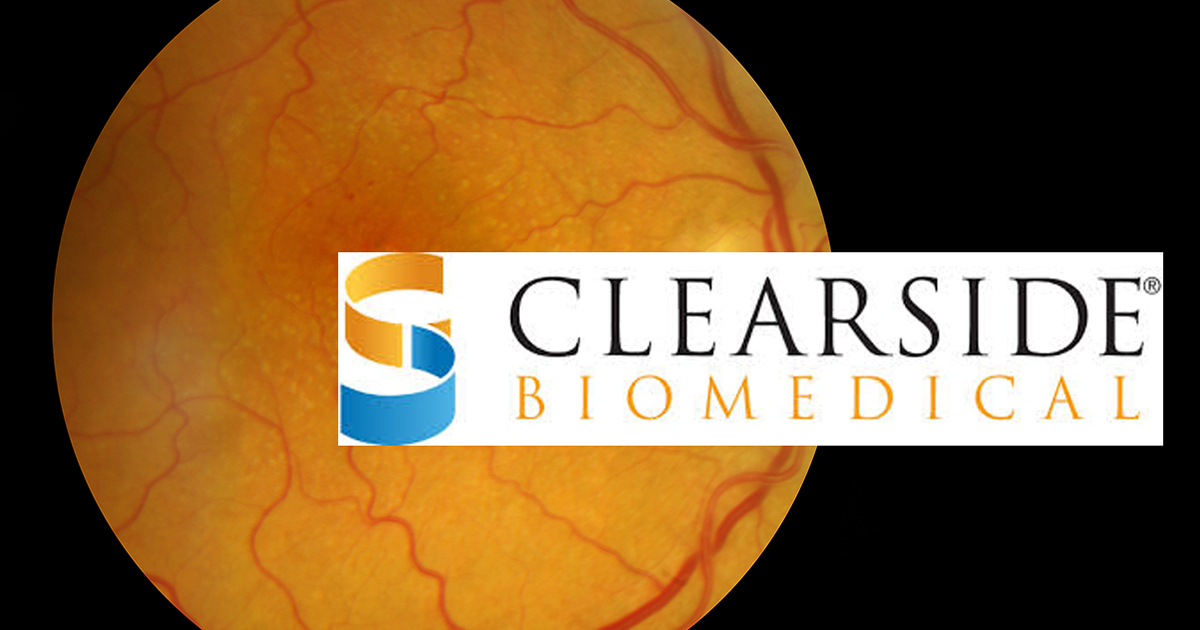Clearside Girds to Take CLS-TA to Next Level

“Everything kind of fits together in a puzzle,” Clearside Biomedical CEO and president Daniel H. White tells OIS Weekly in explaining the company’s recent moves. During the past few weeks, Clearside has made changes in the C-suite to pivot the company to commercialize its feature product, released encouraging clinical trial results of that product in two key ophthalmic indications, and then announced a public offering to raise $75 million to fund that pivot and further develop its lead candidate.
Uveitis Breakthrough
Clearside is pursuing a multi-pronged approach in developing CLS-TA, a formulation of the corticosteroid triamcinolone acetonide that a proprietary mircroinjector system delivers into the suprachoroidal space – the area between the choroid and the outer surface of the eye, known as the sclera. The drug traverses that layer to reach the back of the eye to target macular edema.
One prong of the approach involves an indication for noninfectious uveitis, for which the company reported positive top-line results from a pivotal Phase III trial. In the study, known as the PEACHTREE trial, 47% of patients who received the CLS-TA treatment every 12 weeks gained at least 15 letters of best-corrected visual acuity (BCVA).
The trial also showed that treated patients had an average reduction of retinal central subfield thickness – a key inflammatory biomarker in macular edema – of 157 microns at week 24 versus 19 microns in the sham arm at 24 weeks. Through the same period, 11.5% of patients reported elevated intraocular pressure (IOP). White tells OIS Weekly those results compare favorably to the IOP rise in other types of corticosteroid treatments for uveitis.
With these results in hand, Clearside expects to file a new drug application for the uveitis indication in the fourth quarter, White says.
Anti-VEGF Strategy
Another prong of the development of CLS-TA involves investigating combination therapy with the three leading anti-VEGF agents. Clearside just reported updates on two Phase III trials of CLS-TA for treatment of macular edema associated with retinal vein occlusion (RVO): TOPAZ, which is investigating combination treatment with Lucentis (ranibizumab) or Avastin (bevacizumab, both Roche/Genentech); and SAPPHIRE, which is testing Eylea (Regeneron). TOPAZ just started enrolling, but SAPPHIRE is progressing faster than anticipated; the company moved up the expected date for preliminary results from Q1 2019 to Q4 this year.
“We’re just taking this to the next level,” White says. “If we show benefit with all these anti-VEGFs, we’re hopeful that the FDA will give us a label that provides for any anti-VEGF treatment in combination with our CLS-TA.”
C in C-Suite Means ‘Commercialize’
To get to that next level, Clearside brought in some new talent: William Humphries as chairman, and Brion Raymond as chief commercial officer.
Humphries spent most of his 30 years in specialty pharma in product commercialization. He covers the bases with experience at two of the big players in ophthalmology: Valeant, where he’s currently executive vice president of the Ortho Dermatologics division; and Allergan, where he’s held multiple senior executive roles, the last as vice president of its US skin care business. “Bill is accomplished in helping build commercial teams and launching new treatments,” White says.
Humphries succeeds Christy L. Shaffer, PhD, a venture partner and managing director of Hatteras Discovery. She will remain on the board.
Raymond likewise held commercial leadership roles at a couple of ophthalmology heavyweights: Genentech and Carl Zeiss Meditec. Before joining Clearside, he managed a consulting firm that led multiple strategy projects for clinical-stage biotechnology companies.
“Brion’s experience brings a particularly relevant depth of knowledge of ophthalmic biopharmaceutical product launches and strong relationships in the retina community to Clearside,” White says. “At Genentech, he was a key member of the team responsible for launching Lucentis, and we are thrilled to have an executive of his caliber join our team in this important new position.”
IPO Helps Fund It All
With the $75 million it expects to raise from its IPO, Clearside intends to fund the new drug application for the CLS-TA noninfectious uveitis indication and its commercialization of the indication. The company also plans to continue the Phase III SAPPHIRE clinical trial in RVO, complete the Phase II TYBEE trial in diabetic macular edema, and initiate the second Phase III TOPAZ clinical trial in RVO.
For questions regarding this article, or other articles published on ois.net, please contact Richard Mark Kirkner: Rich@healthegy.com

